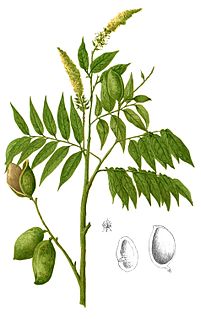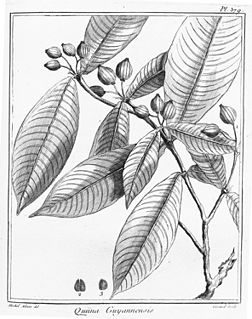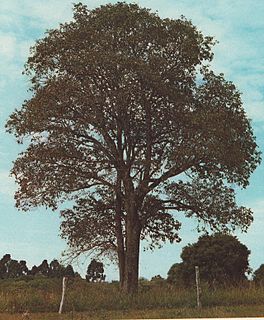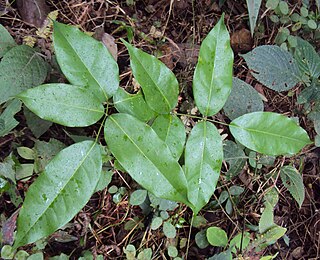
Mammea is a flowering plant genus with about 70 species in the family Calophyllaceae. Its members are evergreen trees having edible fruits. The flowers are polygamous, with a unitary calyx opening into two or three valvate sepals. There are 4 to 8 petals. Berries are formed, containing 1 to 4 seeds. The leaves are rigid, coriaceous and often have pellucid dots.

Chrysochlamys is a plant genus of the family Clusiaceae.

Vismia is a genus of flowering plants in the family Hypericaceae. Members of the genus are small trees and shrubs found in tropical and subtropical areas of Africa, Central America, and South America.

Symphonia is a genus of tropical woody plants, specifically trees in the family Clusiaceae. The genus has its diversity center in Madagascar and one species disjunct in the Afrotropic and the Neotropic in the Amazon Rainforest.

Mesua is a genus of flowering plants in the family Calophyllaceae, native to tropical southern Asia. Common names include ironwood and rose chestnut.

José Jerónimo Triana Silva was a Colombian botanist, explorer, and physician who cataloged over 60,000 specimens representing 8,000 species.

Crudia is a genus of plants in the family Fabaceae.

Henriettea is a genus of flowering plants in the family Melastomataceae, with some 68 species accepted. It is distributed in the Americas. Some species in the genus are known commonly as camasey.

Marcgravia is a genus of plants in the Marcgraviaceae family commonly eaten by the dwarf little fruit bat the plant is native to the Caribbean Islands, Central America, and South America. The genus is named in memory of the German naturalist Georg Marcgraf. The plant is visited by Thomas's nectar bat.

Quiina is a genus of plant in family Ochnaceae. It contains the following species :

Tetracera is a genus of flowering plants of the Dilleniaceae family; several species are lianas.

Luehea is a genus of trees in the family Malvaceae.

Rourea is a genus of plants in the family Connaraceae. They are found worldwide across the tropics and subtropics.
Morisonia is a genus of flowering plants in the family Capparaceae, found across the Americas from the United States to Argentina. It was recently enlarged with New World Capparis species due to existing taxonomic instability. They tend to be shrubs or small trees.
Thinouia is a genus of flowering plants belonging to the family Sapindaceae.
Dendrosida is a genus of flowering plants belonging to the family Malvaceae.
Sidastrum is a genus of flowering plants belonging to the family Malvaceae.
Ruyschia is a genus of flowering plants belonging to the family Marcgraviaceae.
Sarcopera is a genus of flowering plants belonging to the family Marcgraviaceae.
Marcgravia rectiflora is a plant species native to Peru and Central America.












